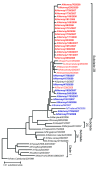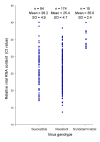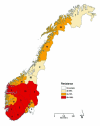Oseltamivir-resistant influenza viruses A (H1N1), Norway, 2007-08
- PMID: 19193257
- PMCID: PMC2657637
- DOI: 10.3201/eid1502.081031
Oseltamivir-resistant influenza viruses A (H1N1), Norway, 2007-08
Abstract
In Norway in January 2008, unprecedented levels of oseltamivir resistance were found in 12 of 16 influenza viruses A (H1N1) tested. To investigate the epidemiologic and clinical characteristics of these viruses, we used sequence analysis to test all available subtype H1N1 viruses from the 2007-08 season for resistance. Questionnaires from physicians provided information on predisposing diseases, oseltamivir use, symptoms, and complications. Clinical data were obtained for 265 patients. In total, 183 (67.3%) of 272 viruses were oseltamivir resistant. Resistance was not associated with prior use of antiviral drugs. Symptoms and hospitalization rates did not differ for patients infected with a resistant or a susceptible virus. Oseltamivir-resistant influenza viruses A (H1N1) did not show diminished capability to spread in the absence of selective pressure. The ability of these viruses to sustain their fitness and spread among persons should be considered when shaping future strategies for treating and preventing seasonal and pandemic influenza.
Figures




References
-
- Aavitsland P, Hauge S, Borgen K. Rare usage of oseltamivir in Norway prior to emergence of oseltamivir resistant influenza A(H1N1) virus in the 2007–2008 season. 2008. International Conference on Emerging Infectious Disases; 2008 Mar 16–19; Atlanta. Addendum 11.
MeSH terms
Substances
LinkOut - more resources
Full Text Sources
Other Literature Sources
Medical
